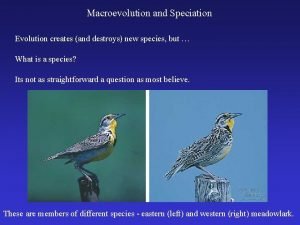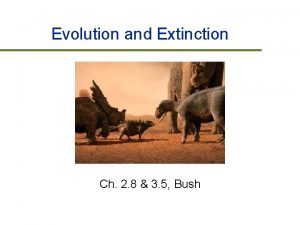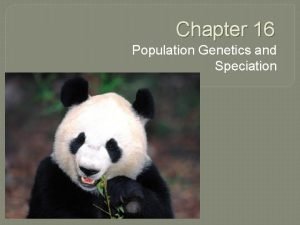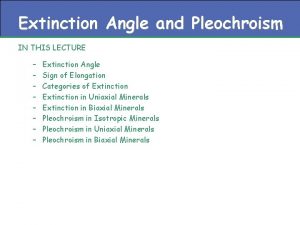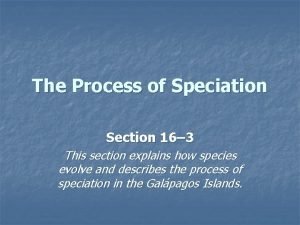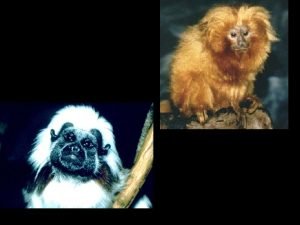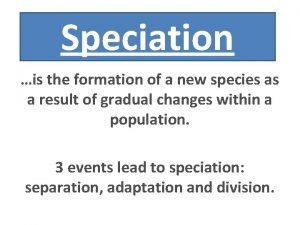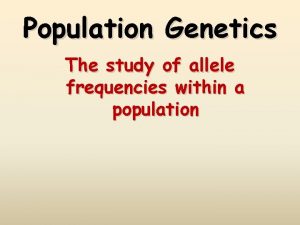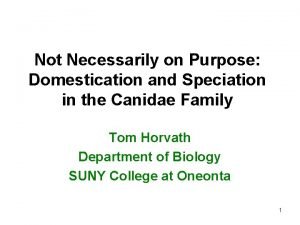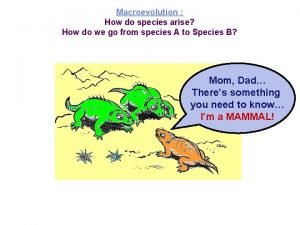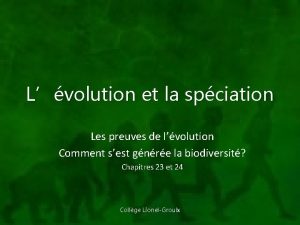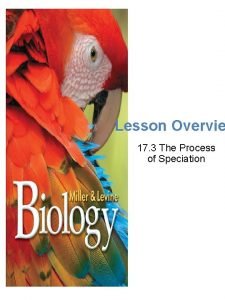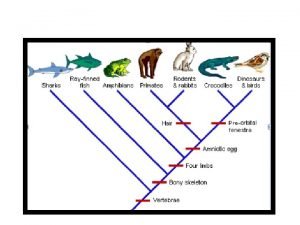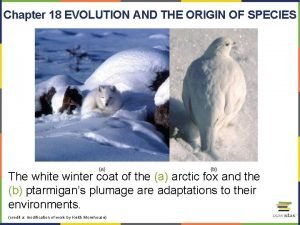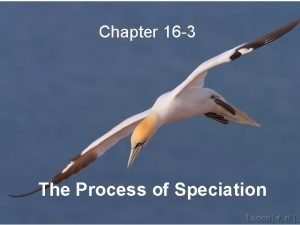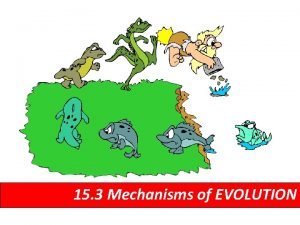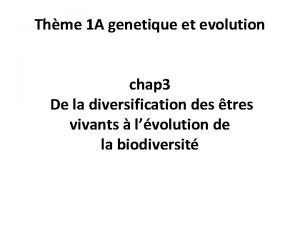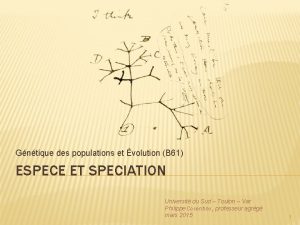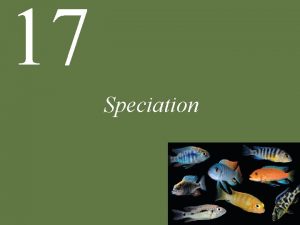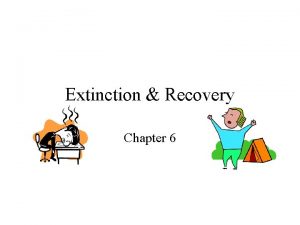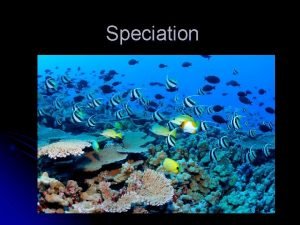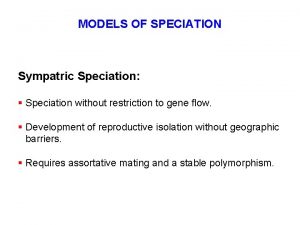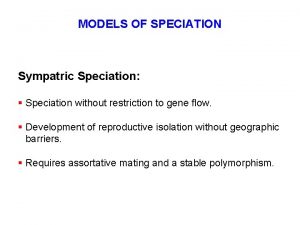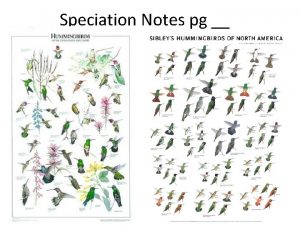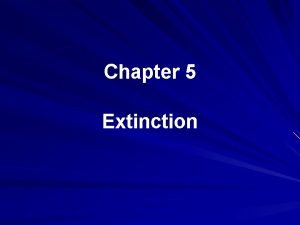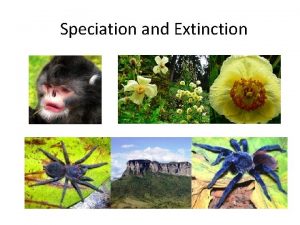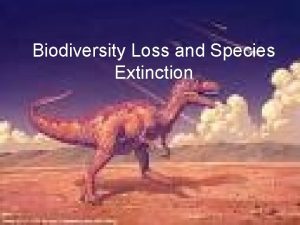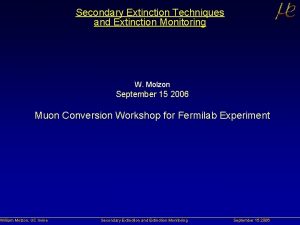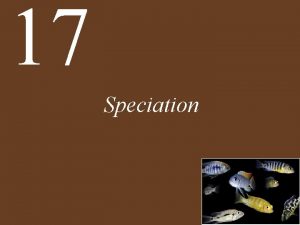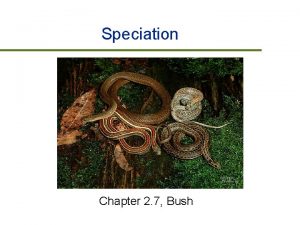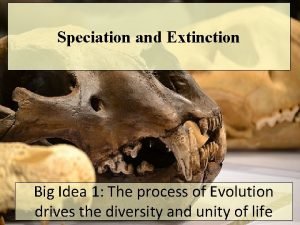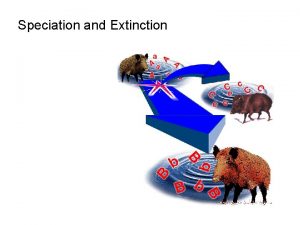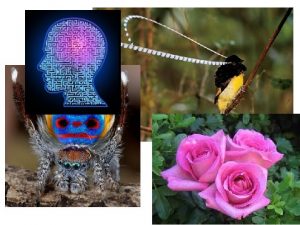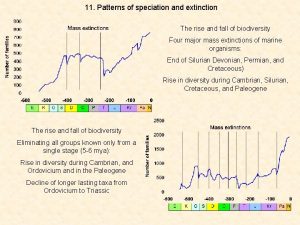SPECIATION AND EXTINCTION Chapter 17 A What Is

![A. What Is a Species? 1. The Species Concept ] Carolus Linnaeus (1707 -1778) A. What Is a Species? 1. The Species Concept ] Carolus Linnaeus (1707 -1778)](https://slidetodoc.com/presentation_image_h2/50585524c85ff26d13e382d775ba8af1/image-2.jpg)

![2. Species Relationships ] Linnaeus thought that each species was created once, and did 2. Species Relationships ] Linnaeus thought that each species was created once, and did](https://slidetodoc.com/presentation_image_h2/50585524c85ff26d13e382d775ba8af1/image-4.jpg)
![] Darwin proposed that evolution occurs in a branched fashion, with one major species ] Darwin proposed that evolution occurs in a branched fashion, with one major species](https://slidetodoc.com/presentation_image_h2/50585524c85ff26d13e382d775ba8af1/image-5.jpg)



![] Behavioral isolation - prevents mating; individuals have different courtship rituals. ] Mechanical isolation ] Behavioral isolation - prevents mating; individuals have different courtship rituals. ] Mechanical isolation](https://slidetodoc.com/presentation_image_h2/50585524c85ff26d13e382d775ba8af1/image-9.jpg)
![Mechanical Isolation Example: ] Cotton bollworms and tobacco budworms cost almost $1 billion annually Mechanical Isolation Example: ] Cotton bollworms and tobacco budworms cost almost $1 billion annually](https://slidetodoc.com/presentation_image_h2/50585524c85ff26d13e382d775ba8af1/image-10.jpg)
![More crazy reproduction ] Members of the two species differ in their genitalia: copulation More crazy reproduction ] Members of the two species differ in their genitalia: copulation](https://slidetodoc.com/presentation_image_h2/50585524c85ff26d13e382d775ba8af1/image-11.jpg)
![2. Postzygotic Reproductive Barriers Act after the zygote is formed. ] Hybrid inviability - 2. Postzygotic Reproductive Barriers Act after the zygote is formed. ] Hybrid inviability -](https://slidetodoc.com/presentation_image_h2/50585524c85ff26d13e382d775ba8af1/image-12.jpg)





![Speciation can occur gradually [gradualism] or in “leaps & starts” [punctuated equilibrium]. Speciation can occur gradually [gradualism] or in “leaps & starts” [punctuated equilibrium].](https://slidetodoc.com/presentation_image_h2/50585524c85ff26d13e382d775ba8af1/image-18.jpg)


![Examples of Mass Extinctions: ] 250 mya (Permian) - referred to as the “mother Examples of Mass Extinctions: ] 250 mya (Permian) - referred to as the “mother](https://slidetodoc.com/presentation_image_h2/50585524c85ff26d13e382d775ba8af1/image-21.jpg)
![] 65 mya (K/T boundary) - nearly 75% of all species (including the dinosaurs) ] 65 mya (K/T boundary) - nearly 75% of all species (including the dinosaurs)](https://slidetodoc.com/presentation_image_h2/50585524c85ff26d13e382d775ba8af1/image-22.jpg)
![Politics & Species ] Native species are protected. ] Wild / feral mustangs in Politics & Species ] Native species are protected. ] Wild / feral mustangs in](https://slidetodoc.com/presentation_image_h2/50585524c85ff26d13e382d775ba8af1/image-23.jpg)
- Slides: 23

SPECIATION AND EXTINCTION Chapter 17
![A What Is a Species 1 The Species Concept Carolus Linnaeus 1707 1778 A. What Is a Species? 1. The Species Concept ] Carolus Linnaeus (1707 -1778)](https://slidetodoc.com/presentation_image_h2/50585524c85ff26d13e382d775ba8af1/image-2.jpg)
A. What Is a Species? 1. The Species Concept ] Carolus Linnaeus (1707 -1778) defined a species as: “All examples of creatures that were alike in minute detail of body structure”. ] Ernst Mayr (1940) defined a species as: A population, or group of populations, whose members can potentially interbreed & produce fertile offspring.

Though Mayr’s species definition is utilized by scientists today, it is not perfect. How do you classify organisms that: F have the potential to interbreed, but do not do so in nature? F do not reproduce sexually? F exist only as fossils? DNA & protein sequence analysis have helped fill in some of these gaps.
![2 Species Relationships Linnaeus thought that each species was created once and did 2. Species Relationships ] Linnaeus thought that each species was created once, and did](https://slidetodoc.com/presentation_image_h2/50585524c85ff26d13e382d775ba8af1/image-4.jpg)
2. Species Relationships ] Linnaeus thought that each species was created once, and did not change. ] Lamarck believed that one type of organism evolved into another, progressing toward perfection.
![Darwin proposed that evolution occurs in a branched fashion with one major species ] Darwin proposed that evolution occurs in a branched fashion, with one major species](https://slidetodoc.com/presentation_image_h2/50585524c85ff26d13e382d775ba8af1/image-5.jpg)
] Darwin proposed that evolution occurs in a branched fashion, with one major species giving rise to others.

Branching diagrams are utilized today to represent phylogenies (evolutionary relationships between species). Recently, molecular data (DNA & protein sequencing) has allowed researchers to confirm or revise existing phylogenies. Monotremes: egg-laying mammals (next slide)

Monotremes: spiny anteater (echidna) & duckbilled platypus

B. Reproductive Isolating Mechanisms Reproductive barriers that function to maintain separate species. 1. Prezygotic Reproductive Barriers Act before zygote is formed. ] Ecological isolation - prevents mating; individuals mate/flower in different habitats. ] Temporal isolation - prevents mating; individuals mate/flower at different seasons or times of day.
![Behavioral isolation prevents mating individuals have different courtship rituals Mechanical isolation ] Behavioral isolation - prevents mating; individuals have different courtship rituals. ] Mechanical isolation](https://slidetodoc.com/presentation_image_h2/50585524c85ff26d13e382d775ba8af1/image-9.jpg)
] Behavioral isolation - prevents mating; individuals have different courtship rituals. ] Mechanical isolation - mating is attempted, but structural differences prevent copulation/pollen transfer. ] Incompatible gametes - mating occurs; however, sperm cannot penetrate oocyte.
![Mechanical Isolation Example Cotton bollworms and tobacco budworms cost almost 1 billion annually Mechanical Isolation Example: ] Cotton bollworms and tobacco budworms cost almost $1 billion annually](https://slidetodoc.com/presentation_image_h2/50585524c85ff26d13e382d775ba8af1/image-10.jpg)
Mechanical Isolation Example: ] Cotton bollworms and tobacco budworms cost almost $1 billion annually in USA crop damages. ] In 1982, the USDA scientists worked with synthetic sex pheromones to confuse the male budworms and reduce mating. ] Unexpected: it lured male bollworms to mate with female budworms. Soooooo…
![More crazy reproduction Members of the two species differ in their genitalia copulation More crazy reproduction ] Members of the two species differ in their genitalia: copulation](https://slidetodoc.com/presentation_image_h2/50585524c85ff26d13e382d775ba8af1/image-11.jpg)
More crazy reproduction ] Members of the two species differ in their genitalia: copulation took place but the “mismatched pair” can’t separate. ] This is another reason why no one should mate outside their own species. ] The insect duos died, “locked in a deadly embrace. ”
![2 Postzygotic Reproductive Barriers Act after the zygote is formed Hybrid inviability 2. Postzygotic Reproductive Barriers Act after the zygote is formed. ] Hybrid inviability -](https://slidetodoc.com/presentation_image_h2/50585524c85ff26d13e382d775ba8af1/image-12.jpg)
2. Postzygotic Reproductive Barriers Act after the zygote is formed. ] Hybrid inviability - zygote forms, but fails to develop or survive to reproduce. ] Hybrid sterility - hybrid offspring are healthy, but infertile. ] Hybrid breakdown - hybrid offspring are healthy & fertile; however, with each generation, fewer hybrids survive.

C. Speciation The formation of new species. 1. Allopatric Speciation occurs in populations that are physically separated by a geographic barrier. F Barrier stops gene flow between populations. F The forces of evolutionary change act independently on each to establish reproductive barriers.


2. Parapatric Speciation occurs in populations that inhabit neighboring areas. F Individuals tend to mate within their own populations, restricting gene flow. F Speciation occurs when genetic divergence between the two populations exceeds gene flow.


3. Sympatric Speciation occurs in populations that share a habitat. Sympatric speciation results from: F Ecological isolation F Polyploidy (number of sets of chromosomes increases). Allopatric speciation is considered to be the most common mechanism of speciation.
![Speciation can occur gradually gradualism or in leaps starts punctuated equilibrium Speciation can occur gradually [gradualism] or in “leaps & starts” [punctuated equilibrium].](https://slidetodoc.com/presentation_image_h2/50585524c85ff26d13e382d775ba8af1/image-18.jpg)
Speciation can occur gradually [gradualism] or in “leaps & starts” [punctuated equilibrium].

D. Extinction The disappearance of a species. Extinction is usually caused by: F decrease in genetic variability. -increases vulnerability to pathogens. -tends to bring together deleterious lethal alleles. F failure to adapt to a changing environment.

1. Background Extinctions The common extinctions that happen gradually as populations shrink. 2. Mass Extinctions The disappearance of many species over relatively short periods of time. Paleontologists have identified several mass extinctions.
![Examples of Mass Extinctions 250 mya Permian referred to as the mother Examples of Mass Extinctions: ] 250 mya (Permian) - referred to as the “mother](https://slidetodoc.com/presentation_image_h2/50585524c85ff26d13e382d775ba8af1/image-21.jpg)
Examples of Mass Extinctions: ] 250 mya (Permian) - referred to as the “mother of mass extinctions” because so many species perished. F 90% of all marine species F 30% of all insect orders F 66% of amphibian & reptilian families Permian extinctions due to a sequence of events: drop in sea level; increase in atmospheric and oceanic CO 2; volcanic eruptions; & a rise in sea level.
![65 mya KT boundary nearly 75 of all species including the dinosaurs ] 65 mya (K/T boundary) - nearly 75% of all species (including the dinosaurs)](https://slidetodoc.com/presentation_image_h2/50585524c85ff26d13e382d775ba8af1/image-22.jpg)
] 65 mya (K/T boundary) - nearly 75% of all species (including the dinosaurs) perished. Cretaceous extinctions were the result of an asteroid that crashed into Chicxulub, Mexico. ] 11, 000 years ago - many species of large mammals (saber-toothed tigers, mastodonts) perished. Humans probably caused these extinctions.
![Politics Species Native species are protected Wild feral mustangs in Politics & Species ] Native species are protected. ] Wild / feral mustangs in](https://slidetodoc.com/presentation_image_h2/50585524c85ff26d13e382d775ba8af1/image-23.jpg)
Politics & Species ] Native species are protected. ] Wild / feral mustangs in the American southwest are considered a nuisance by ranchers and horses have been killed. ] Horses are native to America, so there is thought to protect them as a native species
 Antelope squirrel allopatric speciation
Antelope squirrel allopatric speciation Emblem
Emblem The sixth extinction chapter 3 summary
The sixth extinction chapter 3 summary Population genetics and speciation worksheet answer key
Population genetics and speciation worksheet answer key Extinction angle definition
Extinction angle definition Section 16–3 the process of speciation
Section 16–3 the process of speciation Speciation
Speciation How does speciation occur
How does speciation occur Speciation, or the formation of new species, is
Speciation, or the formation of new species, is Sympatric speciation example
Sympatric speciation example Factors affecting gene frequency slideshare
Factors affecting gene frequency slideshare Canidae cladogram
Canidae cladogram Hybrid fertility
Hybrid fertility La spéciation
La spéciation Process of speciation
Process of speciation Sympatric speciation def
Sympatric speciation def Ecological speciation
Ecological speciation Name:the origin of species ch:18
Name:the origin of species ch:18 16-3 the process of speciation
16-3 the process of speciation Allopatric speciation
Allopatric speciation écureuil-antilope grand canyon
écureuil-antilope grand canyon Speciation ecureuil antilope
Speciation ecureuil antilope Embryo development
Embryo development Speciation
Speciation
